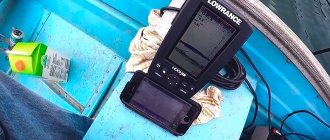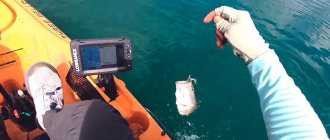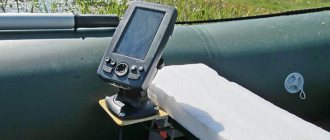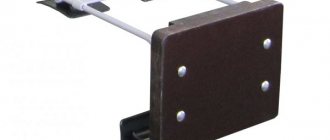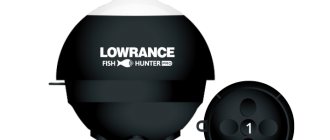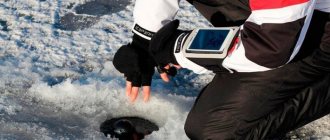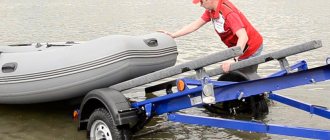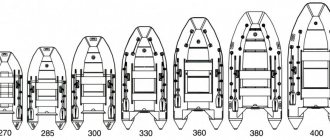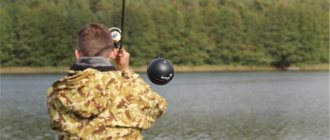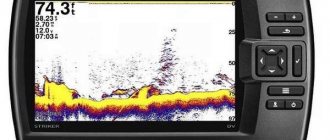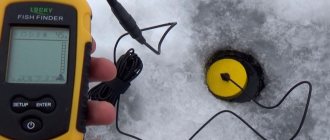Today, many new techniques and technologies are used for fishing. This significantly increases the efficiency of the process. Among experienced fishermen, such a device as an echo sounder is in great demand. This device allows you to determine the depth in the reservoir, the presence of fish below the sensor and other characteristics. There are many models of this equipment on sale.
An echo sounder for a PVC boat with a motor is in high demand. Unlike wireless devices that are used for fishing from the shore, it transmits the signal more clearly. Wired fish finders will also cost less. Advice from experienced fishermen will help you on how to select and install such devices.
Inexpensive echo sounders
Today, for 10-20 thousand rubles ($150-300) you can purchase a working echo sounder with a high-quality color display and DualBeam technology, which involves scanning water with two beams.
Competition among manufacturers in this price category is very high, and therefore the range of such echo sounders for PVC boats is quite large.
A good price-quality ratio is typical for devices from such well-known companies as Humminbird, Lowrance, Garmin and Phiradar, and therefore we will talk about individual devices from these manufacturers further.
LUCKY FF1108-1
A good inexpensive echo sounder LUCKY FF1108-1 is suitable for year-round fishing. This device operates reliably at temperatures from -20°C to +50°C; the wired sensor can withstand the same conditions. A small beam angle (45°), although it somewhat narrows the possibilities of finding fish, but transmits a clearer image to the color display screen. The device operates at depths of up to 100 m. The functionality of the device is revealed more when fishing from a boat and during winter fishing, when the sensor can be lowered below the water's edge and get a more complete picture of the underwater world. This feature is not available for float-type echo sounders. This simplest echo sounder allows you to select sensitivity, as well as a sound alert about the presence of fish in its coverage area.
- a reliable and simple device with fairly wide functionality.
- high accuracy of depth measurement - up to 100 m.
- acceptable cost - at the level of 4,000 rubles.
- b/w screen scanning depth up to 100 m 1 beam.
- portable design.
- transducer in the form of a float.
- powered by batteries/accumulators
Lowrance Mark-5x PRO
This black-and-white, low-cost, dual-frequency model from Lawrence features a high-resolution five-inch display with a modern design and improved auto mode. The operating temperature ranges from -15 to 55 degrees. Thanks to the backlight of the screen, the sonar can work effectively both during the day and at night.
The maximum scanning limit at the prospective location is 305 m, and the total radiation angle is 120 degrees. Mark also attracts the attention of anglers with the presence of a useful TrackBack function, which allows you to view the history of received data. Second place in our ranking.
Practitioner ER-6PRO
Portable domestic echo sounder. Operates in a temperature range from -20° to 40°C. This spread allows it to be used both in hot weather and in cold winter. The echo sounder is powered by one AA battery. Small in size and with only one beam, with a scanning depth of 25m .
This specimen initially leaves a very negative opinion about itself. However, in the process of using it, it gradually gains trust. The low price, as well as the presence of 5 different operating modes, make the device simply indispensable for fishing.
Disadvantages also include stiff buttons , which are sometimes difficult to press in winter.
Transmitter power
From the physics course taught in high school, everyone knows that water suppresses sound waves. Therefore, the operating depth of the unit will depend on the transmitter power.
This indicator determines the strength of the sound signal supplied to the receiver while it is in the water. That is, the resulting picture will be clearer and more understandable, the more powerful the device produces the signal.
At the same time, devices with the best transmitters will represent the most expensive price category, this also needs to be taken into account.
Directly related to this characteristic is another one – receiver sensitivity.
What to pay attention to
As a rule, small inflatable boats are used in local areas. They are equipped with low-power outboard engines, which allow them to move around the water area with some restrictions. Firstly, the speed of movement of such a craft is insignificant. Secondly, it is impossible to cover long distances with such a set.
Therefore, rubber boats with a motor require simple instruments. They are required to solve two main tasks:
- Measuring depth and its changes.
- Monitoring the bottom topography and displaying information on the display.
All budget echo sounders have similar basic functions. Actually, this is their main purpose. As the cost of a product increases, its capabilities increase. The presence of some is critical for large reservoirs, but in our case they can be neglected.
The power of the sensor affects the scanning depth of the echolocator and the quality of the transmitted information. Naturally, more powerful devices are able to “pierce” the water column better and provide a clearer picture. The higher this indicator, the more expensive the product will cost.
However, the quality of the image displayed on the monitor depends not only on the power of the sensor. If the receiver turns out to be weak, then you shouldn’t even dream about clear, highly accurate information. In addition, the larger the display and the better its resolution, the more convenient it is to read the image, and the better the small details of the bottom are visible.
The presence of additional “chips” in an echo sounder is always welcome. The main thing is that they do not interfere with the ease of use of the device for its intended purpose and do not degrade the quality of bottom scanning. The main auxiliary options in inexpensive echo sounders for fishing from a boat are:
- Water temperature sensor;
- Ability to change image scale;
- Adjust display sensitivity;
- Boat speed detection sensor;
- Fish detection function;
- Additional settings for font size and image quality on the screen.
Which echo sounder is suitable for sea fishing?
Marine echo sounders are designed for great depths and scanning of water columns in conditions of strong currents and a wide variety of terrain. For sea fishing, modern models with transducers equipped with long waterproof cables are suitable. They must be supplemented with batteries and plastic cases for transportation.
It is necessary that echo sounders can clearly display the structure of the bottom and have at least two beams. Single-beam options are not capable of qualitatively exploring the sea space and create a lot of interference. It is better to choose equipment with a powerful professor that processes a decent amount of information in a split second. A fish found in the sea may change location, frightened by the sound of a boat moving or the silhouette of a boat. You need to approach it quickly, otherwise you will then have to look for prey throughout the entire water area. Therefore, the echo sounder needs to instantly process the data and display it on the display.
How to install
Immediately before installing the echo sounder on the boat, carefully determine the mounting location. When choosing a place for mounting, you need to take into account two factors, the first is the shape of the bracket (usually supplied as standard) and the particular shape of your PVC boat. Please note that the accessory sensor must be in a parallel plane with the water surface and be completely immersed in water. It is worth being aware that if you attach the echo sounder sensor at any angle other than 90 degrees, the readings from the device itself may differ from reality.
Also, attaching an echo sounder to a PVC boat requires the fisherman to take into account the air that gets under the bottom while moving. Air bubbles that get under the boat while moving can affect the sensor and its readings will not be entirely reliable. Because of this, you need to choose a place to install the sensor so that air exposure to it is as small as possible.
If you have a large inflatable boat, then there should be no problems; the stern would be the ideal place to mount the echo sounder sensor. But here there will be a slightly different problem, the factory brackets are not very strong, and if you hit an obstacle, you can break either the bracket, if you’re lucky, or, if not, the transom. This is at your own peril and risk, but I would immediately replace the bracket with a homemade one, I will have to write an article on how to make it. A mechanism for throwing away the bracket in case of emergency can be a very useful thing; I installed such a thing for myself right away, it helps.
Well, for the truly desperate, you can try gluing the sensor into the hull of the boat itself. ATTENTION, do this only if you are absolutely sure that you will not harm your inflatable boat in any way. This scam can only be pulled off if your boat is made of:
- PVC;
- Rubbers;
- Fiberglass.
To mount the echo sounder inside a PVC boat, you should choose exactly the place on the bottom that will be parallel to the water in any conditions. Well, I won’t describe the installation, I think everyone will have the courage to just cut a hole, put the sensor in there and then seal the boat.
An interesting thing, if you have an inflatable boat, then it supposedly has Velcro, so it’s best to attach the bracket to it. But you need to be very careful so as not to simply lose the sensor; it is best to come up with a more reliable mount. It’s better to attach it to the seat of the boat; a piece of metal-plastic tube can help us with this; we simply bend it and screw it to the seat. We attach our treasured sensor to the other end of the tube.
In short, the whole point of attaching an echo sounder is to attach its sensor. Well, we simply mount the screen in a visible place, depending on your personal preference and desire.
Number of radio rays
A special part is the sensor at the echo sounder on a rubber boat. Depending on the features of the model, it can produce one or more beams. Both options have their advantages and disadvantages:
- Single-beam units are characterized by a narrowly targeted effect. That is, the image transmitted from them will show only a limited sector of the reservoir.
- Aggregates in which the number of such rays is 2-4 provide a more complete image. They are often characterized as a kind of “lateral vision”.
They make it easier to examine areas of the reservoir that are located to the side.
Of course, echo sounders with 4-5 beams will show the most complete picture of the state of the bottom under water. But they also have a significant drawback - the so-called dead zones. Their presence will depend on the ability to adjust the basic parameters of the emitters to specific terrain conditions. Otherwise, the echo sounder will not demonstrate the expected effect.
Main characteristics
Like any other electronic device, echo sounders have a set of basic characteristics that are a dictating factor when choosing it.
- The first and practically the most important parameter of any sonar is the transmitter power. The higher it is, the more efficiently and correctly the device can record objects at depth.
- You should definitely pay attention to the screen resolution. The clarity of the displayed information directly depends on the power and configuration of the display. Even if you fish at relatively shallow depths, it is better to choose models with a power of at least 500-600 watts. The screen can be either black and white or color depending on the model. Lately, expensive 3D echo sounders have become very popular.
Additional features typically include:
- “zoom” by analogy with a camera - a close-up view of the bottom (detailed review);
- “alarm” is a sound alarm that reports various changes, from entering shallow water to detecting fish of the required size;
- “grayline” function allows you to distinguish living objects from various natural ones;
- “fishtrack” - the ability to track the movement of fish within the operation of the echo sounder;
- "fish-ID" identifies fish on the screen with a clear symbol.
Basic parameters of echo sounders
Before choosing an echo sounder for a rubber boat, you need to familiarize yourself with its basic parameters and technical characteristics. These include the following features:
- degree of sensitivity of the receiver;
- display contrast and dimensions;
- price parameters of models;
- transmitter power;
- operating frequency;
- number of rays;
- manufacturer.
Each of them is worth considering in detail. Specialized stores offer units with an expanded or reduced number of options. Although most of them are considered additional services and determine only ease of use, they do not have a significant impact directly on the fishing process.
Budget
If, when choosing a fish finder, you do not look at the price, but simply want to get the best device available on the market, then you can safely skip this section. Here we will talk about which brand is the most budget-friendly, and at the same time can offer the maximum functionality for your money.
Lowrance has the most offerings in the low price range. Their models tend to be a little cheaper than others with similar features. Among the devices, you can choose the most suitable one for yourself, eliminating unnecessary functions. Thereby saving a little more. As for the premium segment, the price tag here is also usually lower than that of competitors, which makes these devices ideal for anglers who want to get the most without hitting their wallet hard.
Garmin is generally more expensive than Lowrance, but more affordable than Humminbird. This is mainly due to the fact that the most inexpensive models have slightly more functionality than the former, but a smaller diagonal than the latter. Even so, you shouldn't have any problems finding a good device at a reasonable price.
Finally, the Humminbird . Their overall price index tends to be the highest, especially since they don't offer many models with a 5-inch screen or smaller. And larger models are equipped with an abundance of functions and connectors for connecting additional devices. They have a few affordable mid-range models, but most are in the premium market.
Best models
Here we look at the three best models of each brand in terms of price/quality ratio. We will divide them into inexpensive, best value and premium.
Inexpensive: Striker Plus 4cv
The Striker Plus 4cv is the smallest model, but it has CHIRP sonar capabilities and ClearVu imaging, which is similar to downscanning. It's incredibly small with a 3.5-inch screen, but the brightness and clarity are surprisingly good. You also get Quickdraw Contours to create your own maps. Overall, this is an ideal solution for infrequent fishing trips if you need a functional fish finder with GPS.
Inexpensive: Hook2-4x GPS
A small 4-inch display, ease of use, and automated settings are the main advantages of this model. You get a broadband echo sounder with a maximum scanning depth of up to 150 meters. Suitable for use in both summer and winter. Having accurate GPS allows you to save waypoints and view your path.
Inexpensive: Helix 5 CHIRP GPS G2
As stated above, Humminbird does not have the largest number of devices in the low-cost segment. This brand is more expensive than others, but this is compensated by its quality and functionality. This 5-inch fish finder has onboard support for downscanning, CHIRP. And also amazingly accurate GPS and chartplotter functions.
Best price: Striker Plus 7cv
When serious fishermen talk about Garmin in general, you'll notice that they mention the Plus 7sv most often. This model offers a lot of features, a stunning 7-inch screen with excellent resolution and a simple interface. You can choose between side images, ClearVu and CHIRP sonar, or view everything on the screen at once. GPS is perfectly accurate. There is even access to WiFi for updating maps.
Best Value: Elite 7-Ti
The Elite Ti line is one of Lowrance's best because it offers tons of technical power at a mid-tier price. Elite 7-Ti is the optimal product in this series, there are larger ones, but they all have the same functionality. With this device you will get side image, CHIRP, bottom scan, WiFi and BlueTooth connectivity. As well as slots for microSD cards, many mapping programs and much more. This is the optimal solution at a reasonable price.
Best Price: Helix 7 CHIRP SI GPS G2N
The Helix 7 has side scan, down scan, CHIRP, GPS, and a chartplotter. The device itself has a very easy to use interface. It also has networking capabilities, 3D scanning support, SmartStrike for predicting fish locations, and Ethernet network access.
Premium: EchoMAP Plus 92sv
Similar to the Striker Plus 7sv, you get a combination of SideVu, ClearVu and CHIRP. CHIRP can be used in conjunction with SideVu to produce higher quality images. And the huge 9-inch screen, in turn, provides excellent resolution. The only significant difference is the presence of cartography pre-loaded into the echo sounder.
Premium: HDS 7 Carbon
The HDS series is one of the best in the world, and it's one of Lowrance's best offerings. Thanks to the 7-inch screen, with the best performance in terms of brightness and color reproduction, you will get all possible types of echolocation that are available on the market. For example, such as StructureScan, DownScan, StructureScan 3D, SpotlightScan. In addition, the ability to connect an autopilot, radar, and cartography support. It is worth adding to the above that you will be able to create your own maps, as well as much more.
Operating principle
An echo sounder for sea fishing works on the same principle as its freshwater counterparts: ultrasonic waves (rays) of various frequencies and coverage generated by the transducer rush down and encounter obstacles (fish, submerged objects, the bottom) and are reflected from them. The reflected signals are received by the same sensor and transmitted to the electronic unit, where, after processing, a graphic image of the bottom topography and the presence of single or schooling fish is formed.
Important. This method of echolocation does not provide information that the fish or school of fish shown on the device screen is there at the moment it is displayed. Between the reflection of the signal from the bottom, its transmission and processing by the device, a very short time elapses, equal to fractions of a second. However, with high activity and caution of the fish, it is often enough for the inhabitants of the underwater kingdom, alerted by the sound of a boat engine or its silhouette, to change their location. Therefore, the echo sounder only shows the presence of fish at the moment when the scanning beam was reflected from it and does not guarantee its presence in this place in the future.
Prices for echo sounders for fishing from a boat
In fishing stores and on websites there is a large selection of all kinds of echo sounders for installation in boats, they all differ in functionality, reliability, workmanship and price. The price of boat echo sounders can vary from 6,000 to 300,000 rubles. The most functional models of echo sounders are called chart plotters.
Cheap echo sounders for fishing from a boat
The cheapest echo sounders are Chinese models, which can be purchased on Chinese wholesale sites starting at $30.
The cheapest echo sounders on the AliExpress website were models from FishFinder.
Naturally, the quality of such echo sounders leaves much to be desired, and it would be nice if such an echo sounder showed at least some relief at the bottom of the reservoir.
In general, such cheap echo sounders are not suitable for fishing from a boat, as they will be inconvenient and ineffective in determining the bottom topography, and even more so in identifying fish.
Sonar functions
When considering which echo sounder to choose for a boat, you should consider the existing functions of the presented devices. The design consists of a central block with a screen, which receives information via a wire from a sensor (transducer). It is most often installed on the transom of a PVC boat or on board a rubber flotation device.
The device provides information in graphical form (diagrams, graphs). The numbers indicate a number of important parameters. It can show how deep a body of water is in a given location. The device also conveys the bottom topography quite clearly. This allows you to determine where potential fishing spots are.
The fish like to gather in schools in deep bottom holes. This is where the bait should be directed first. Some models of echo sounders help determine whether there are fish in a given area of a reservoir, and what size individuals predominate in the river. Some device models can even transmit images in color. However, the cost of such equipment is high.
Advantages and disadvantages of device mounting types
To place the device on the bottom, you need to fix it with a special clamp or glue. In this case, it will be fairly well protected from possible damage, but the signal it transmits may not be clear enough. It is not easy to attach an echo sounder to a rubber boat in this way, since for its normal operation it requires a flat surface located in a horizontal plane. And boats made of PVC have a soft rather than hard bottom.
If the boat is equipped with a rigid transom, then it is on it that you can install an echo sounder. This is one of the most commonly used fastening methods, suitable for ships with rigid and inflatable hulls. The transducer is supposed to be lowered below the level of the bottom of the boat, after which it is fixed to the transom using a suitable fastening. There are special so-called transom mounts, which are intended specifically for installing an echo sounder on a rubber boat.
An alternative to all of the above methods is a removable echo sounder mount. It is easiest to implement - usually a pair of suction cups on the boat hull is used to attach it. Most often it is the owners of rubber boats who turn to him. But in such conditions, in the absence of a rigid support, it is difficult to correctly orient the transducer and obtain truly accurate and clear data from it.
Key parameters
When choosing a sonar, an important question remains regarding the basic parameters of the devices. The manufacturer considers the release of echo sounder models differently to ensure a variety of choices.
What is included in the concept of key parameters and how they affect the operation of the device:
- Screen .
The size and resolution of the display determines the clarity of the image not only of large details of the bottom and small-sized fish, but also the determination of the distance to them. This factor makes it possible to properly prepare for fishing in advance, distributing gear in such a way as to maximize the fishing effect. High resolution and contrast make it possible not to strain your eyesight during high sunlight activity. Echo sounders of portable dimensions for catching fish from small boats in the summer are offered for use in models with screens using fastening elements on the wrist. - Fastening . The manufacturer has launched the production of sonars from various types of materials, giving preference to plastic and metal. Types of fastening are divided into three main methods.
The first fastening method is suitable for boats with PVC hulls. Using epoxy glue, the sensors are attached to the boat hull. The vulnerability of this type of fastener is that there are errors and signal distortions.
The second way to install the transmitter is using a transom. This device is suitable for use on quiet boats.
The mobility of the structure is convenient because collisions with other objects are excluded; the brackets are fixed in the water.
Strengthening the sensor in this way is the easiest and most reliable to use.
High-speed boats interfere with the operation of the mushroom propellers of the motors.
The third mounting option involves installing the converter on the bottom of the boat using through holes.
The strongest signal transmission effect. Eliminates transducer interference, is distinguished by the accuracy of depth determination and the quality of signal transmission.
You can also note the portable version of the mounts. There is a lot of controversy surrounding it. The device uses suction cups that can be attached to any accessible surface.
- Sensors _ Depending on the choice of mounting with which the sensors will be installed, they are also divided into three main groups.
The most common transom sensors, due to their ease of installation and maintenance, they are the most popular. The disadvantage of such sensors is the limitation of the explored space: the fisherman will only be able to observe a section of the area behind the stern.
Embedded sensors are ideal for transmitting a signal to a screen display. The appearance of the sensor resembles a large bolt. The sensor is usually installed on the bottom of boats.
Ideal solution for flat bottom boats. This type of sensor can be placed on other surfaces.
The vulnerabilities of these devices are the presence of weak points on the boat’s hull and damage to the sensors when the boat moves through shallow water, where the bottom has uneven surfaces and large objects.
Sensors for internal installation are ineffective in operation; it is this factor that makes many fishermen refuse to use them. When installing internal type sensors, strict compliance with the fastening requirements is required.
Any air pockets and cavities in the joints between the body and the bottom are excluded using epoxy glue. There are restrictions on the thickness of the bottom of the boat.
The advantages of devices of this type: reliable protection from external damage and natural factors, long service life.
Wearable sensors are hybrid mixing. Due to their ability to be installed on a variety of surfaces, they can be used on all types of boat hull surfaces.
The only drawback that the device has is that the mounting system is not perfect.
